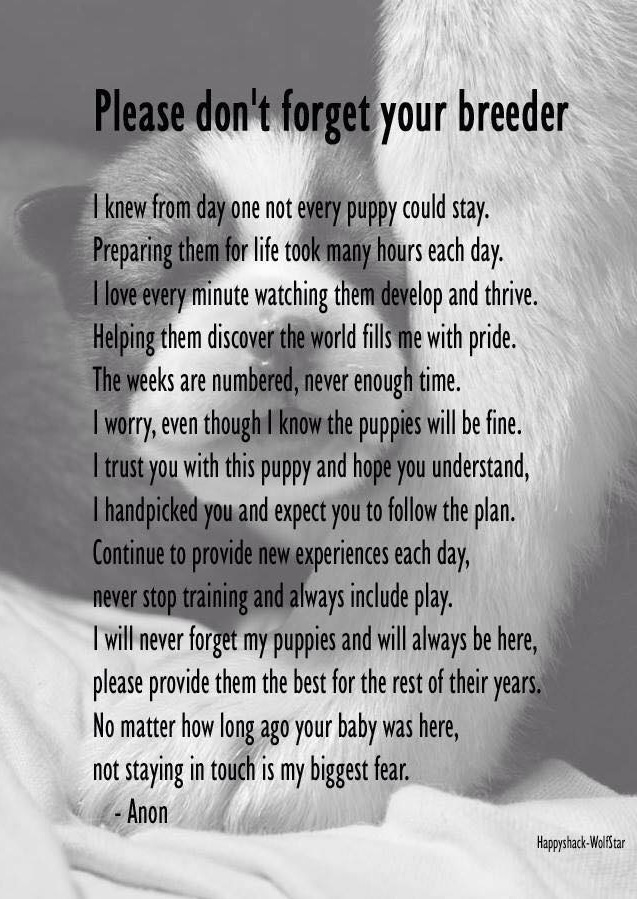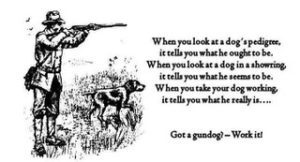by H.S. Lloyd, Ickernham, Middlesex, England
Those who have the true welfare of the Cocker at heart should never lose sight of the Kennel Club’s standard of the breed, which the writer is more than pleased to say is the standard as formulated and approved by the pioneers of the Cocker Club in 1902, gentlemen who had a great knowledge of what they were aiming toward. In coming to these conclusions, the Committee stressed the fact that the Cocker is essentially a working gundog and must be structurally built to fulfill these functions. The diagram as drawn and approved by the Club should be closely studied and memorized. Judges should familiarize themselves with it, and an excellent plan would be to have the diagram pasted in the judging books to refresh the memory. ALL the components that go to make up the standard were not hastily concluded but were the result of many meetings, much “midnight oil”, and trial and error. These gentlemen of a few decades ago were not only genuine shooting men, but were sportsmen in every sense of the word, realizing to the full what was required in a molto in pardon gundog. Before 1902 little effort was made to perpetuate real type, the weight of the animal being the deciding factor. Every exhibit on entering the ring had to be subjected to the scales, and one going over the allowed maximum (25#) got the gate. It therefore followed that many otherwise symmetrically formed specimens erring in the matter of only a few ounces in weight, were debarred: and animals of far less correct build, but within the weight limit, were placed over them. This was all wrong and, thanks to men like the late Mr. J. J. Farrow, founder of the Obos, Mr. Charles Phillips of the Rivington, Mr. R. dec.Peele of the Boulders, and my father, a very strong fight was made for more latitude in the weight questions. When eventually they won the day and the Kennel Club conceded latitude, the breed went ahead rapidly. Up to that period, breeders were shy of using an oversized dog of far superior make and shape and contented themselves with breeding from what were frequently only dwarfed or stunted Field Spaniels, but which came within the weight. Once having overcome this deterrent to progress, the advance in the breed was rapid, and many much more symmetrical, “cockery” specimens began to appear. From this period, in main essentials, type has altered but very little. Of course many were exhibited which were too big and, under good judges, where shown the gate, but progress and popularity of a breed frequently bring exaggerations which defeat the objective of the best intentioned breeders, and must be watched and controlled.
Today we have in great numbers Cockers typical in every respect and which in the words of the great breeder, Mr. R. deC.Peele, represent “pounds for inches” – indeed a lucid way of describing a robustly built animal such as a Cocker should be. JUDGES more than breeders are to blame if the tendency toward over-sized ones has become the recognized thing. Breeders will produce what they see the judges favor. It is up to all judges thoroughly to appreciate weights and measurements and get it well before their eyes before undertaking judge’s appointments. There are far too many dogs winning today that exceed the approximate height and weight limits suggested in the standard, and by a great amount.
A newcomer to judging would be wise to recall the purpose of the breed. In Cockers, stamina and endurance are essential. The build of a sturdily made hunter is required, not one built for great speed nor on the lines of a racehorse, but big in ribs, deep in brisket, and powerful with bone compatible to his size; thus making up an animal capable of fulfilling his working role, to hunt all day in thick cover which more lightly built, leggier animals cannot penetrate. With a picture like this in mind, judges could not put up a narrow-chested, cow-hocked, flat sided specimens.
Originally the Cocker was not asked to retrieve, but was used exclusively for hunting. In the more spacious days a sporting gentleman on his estate kept Retrievers to collect the game.
The re-distribution of wealth which has been taking place over the years greatly restricted the number of dogs an owner could afford, and the Cocker, to exist, had to become a “jack of all trades” and was asked to retrieve. It was quickly discovered that many of the Cockers of that period had not a sufficiently long neck to retrieve to do this successfully and breeders set about to remedy this defect. It may be news to many to know that this was brought about by the introduction of outside influence, through an English Springer who was very closely connected with a famous strain of working English Setters; and the dog who has contributed more than any other to this desirable lengthening of the neck and giving the dignified head carriage that the best of the breed possess was Ch. Invader of Ware who can claim to be the “ (blank)cannot use this word today) in the woodpile” or the savior of the breed, whichever way one wishes to look at it.
At the early field trials Cockers were largely allotted status to themselves, but competed with all the other varieties of the Spaniel family and, as a concession, mainly on account of his size, retrieving for Cockers was optional. It soon became apparent that the top prizes were seldom awarded to a non-retriever, no matter how well he fulfilled his hunting mission in the producing of game for the shooter. The astute breeder quickly saw this opportunity and embraced it by producing better-necked specimens which were capable of retrieving with the bigger ones; and today many of the best judges agreed that no breed now fulfills this duty more efficiently. This digression should prove of value to judges in assessing the merits of dogs brought before them, with the true picture in their eve of what is essential to select as likely progenitors of the right type. Judges should make sure that they do not lose sight of the forest for the trees, and allow some small apparent fault to blind them to the many good points which a specimen possesses.
It is most important for all to bear in mind that the essential thing of any breed is “character”. A breed that has lost character has lost everything. To illustrate what is meant by character, perhaps it is most easily explained by pointing out that a Cocker with an incorrectly placed tail carried cocked up in the air gives it the appearance of a Terrier, and the whole Spaniel “Character” is lost, no matter how many other excellent points it may possess. Alternatively, a Terrier who cannot carry his tail erect and prick his ears loses all “character” and can never be considered typical.
Many times it has been said that judging is not a precise science. Others have expressed the opinion that it is not a science at all but an art, and good artists like good judges are scarce. They are born, not made, and the eye, although it can be cultivated, must be a gift.
To get back to the subject, a Cocker must be symmetrically built, although I am no believer in the yard stick and tape measure. Roughly, a typical Cocker should be the same height from the ground to the point of the withers (apex of shoulder blades), and from the withers to the root of the tail; from the bottom of the top lip to the withers should be the same measurement. If you apply this to what you consider the best specimen you can find, you will discover it is roughly correct. I have measured in this manner many of the best through several generations and have found it is seldom more than a fraction out in the best.
An old breeder of Arabs told me many years ago that in their native land the natives make a point of measuring every foal as soon as he can stand firmly on his legs, and if there is any great divergence, the foal is not reared. The fleetness of their horses and their staying ability were so essential to all Arab tribes that the necessity for breeding their horses on the correct lines is apparent.
With the measurements given, weight must also be taken into account and the “pounds for inches” must apply. Character must also be considered as “temperament” and it is of the utmost importance that the reserved sweet, kindly, retiring character of the Cocker should be preserved. Any noticeable bad temper should be observed and no breeding carried on with any animal that shows too possessive a character or any tendency to viciousness. They should be avoided like the plague. The Cocker has gained a lot of his popularity through the sweet, inoffensive manner which makes him such an ideal home dog and companion for the youngest of children. In one colour of the breed reports have been received of unreliable tempers in a few; and any reports to this effect should be made a Club matter and every effort made to stamp it out. The Irish Setter went through a suspect period through “night blindness” accusations. This was remorselessly fought by the Clubs and the breeders who had the true interest of their breed at heart and , thanks to the honesty of these, the trouble appears to have been stamped out. No tendency to bad tempers can be permitted. Stamp it out at once.
Having been fortunate in living through the embryo stages and watching the evolution of the Cocker over several decades, I must give ALL credit for their present high standard to those pioneers of the past who devoted so much thought and skill to the task, who would never acknowledge the word defeat, and who were very forth right in their opinions of right and wrong conduct of breeders.
This article appears in The English Cocker Spaniel Handbook 1955



